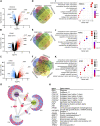Dysregulation of core neurodevelopmental pathways-a common feature of cancers with perineural invasion
- PMID: 37719704
- PMCID: PMC10501147
- DOI: 10.3389/fgene.2023.1181775
Dysregulation of core neurodevelopmental pathways-a common feature of cancers with perineural invasion
Abstract
Background: High nerve density in tumors and metastasis via nerves (perineural invasion-PNI) have been reported extensively in solid tumors throughout the body including pancreatic, head and neck, gastric, prostate, breast, and colorectal cancers. Ablation of tumor nerves results in improved disease outcomes, suggesting that blocking nerve-tumor communication could be a novel treatment strategy. However, the molecular mechanisms underlying this remain poorly understood. Thus, the aim here was to identify molecular pathways underlying nerve-tumor crosstalk and to determine common molecular features between PNI-associated cancers. Results: Analysis of head and neck (HNSCC), pancreatic, and gastric (STAD) cancer Gene Expression Omnibus datasets was used to identify differentially expressed genes (DEGs). This revealed extracellular matrix components as highly dysregulated. To enrich for pathways associated with PNI, genes previously correlated with PNI in STAD and in 2 HNSCC studies where tumor samples were segregated by PNI status were analyzed. Neurodevelopmental genes were found to be enriched with PNI. In datasets where tumor samples were not segregated by PNI, neurodevelopmental pathways accounted for 12%-16% of the DEGs. Further dysregulation of axon guidance genes was common to all cancers analyzed. By examining paralog genes, a clear pattern emerged where at least one family member from several axon guidance pathways was affected in all cancers examined. Overall 17 different axon guidance gene families were disrupted, including the ephrin-Eph, semaphorin-neuropilin/plexin, and slit-robo pathways. These findings were validated using The Cancer Genome Atlas and cross-referenced to other cancers with a high incidence of PNI including colon, cholangiocarcinoma, prostate, and breast cancers. Survival analysis revealed that the expression levels of neurodevelopmental gene families impacted disease survival. Conclusion: These data highlight the importance of the tumor as a source of signals for neural tropism and neural plasticity as a common feature of cancer. The analysis supports the hypothesis that dysregulation of neurodevelopmental programs is a common feature associated with PNI. Furthermore, the data suggested that different cancers may have evolved to employ alternative genetic strategies to disrupt the same pathways. Overall, these findings provide potential druggable targets for novel therapies of cancer management and provide multi-cancer molecular biomarkers.
Keywords: bioinformatics; biomarker; cancer; head and neck squamous cell carcinoma; neurodevelopment; pancreatic ductal adenocarcinoma; perineural invasion; stomach adenocarcinoma.
Copyright © 2023 González-Castrillón, Wurmser, Öhlund and Wilson.
Conflict of interest statement
The authors declare that the research was conducted in the absence of any commercial or financial relationships that could be construed as a potential conflict of interest.
Figures







Similar articles
-
Spatial Transcriptomics Reveals Novel Mechanisms Involved in Perineural Invasion in Pancreatic Ductal Adenocarcinomas.Cancers (Basel). 2025 Mar 1;17(5):852. doi: 10.3390/cancers17050852. Cancers (Basel). 2025. PMID: 40075699 Free PMC article.
-
Perineural invasion-associated biomarkers for tumor development.Biomed Pharmacother. 2022 Nov;155:113691. doi: 10.1016/j.biopha.2022.113691. Epub 2022 Sep 12. Biomed Pharmacother. 2022. PMID: 36095958 Review.
-
A gene expression profile associated with perineural invasion identifies a subset of HNSCC at risk of post-surgical recurrence.Oral Oncol. 2018 Nov;86:53-60. doi: 10.1016/j.oraloncology.2018.09.005. Epub 2018 Sep 13. Oral Oncol. 2018. PMID: 30409320
-
Integrating Clinical and Genetic Analysis of Perineural Invasion in Head and Neck Squamous Cell Carcinoma.Front Oncol. 2019 May 31;9:434. doi: 10.3389/fonc.2019.00434. eCollection 2019. Front Oncol. 2019. PMID: 31214495 Free PMC article.
-
Perineural Invasion in Head and Neck Cutaneous Squamous Cell Carcinoma.Cancers (Basel). 2024 Nov 1;16(21):3695. doi: 10.3390/cancers16213695. Cancers (Basel). 2024. PMID: 39518134 Free PMC article. Review.
Cited by
-
Prognostic Evaluation of Piezo2 Channels in Mammary Gland Carcinoma.Cancers (Basel). 2024 Jun 29;16(13):2413. doi: 10.3390/cancers16132413. Cancers (Basel). 2024. PMID: 39001475 Free PMC article.
References
-
- Badea L., Herlea V., Dima S. O., Dumitrascu T., Popescu I. (2008). Combined gene expression analysis of whole-tissue and microdissected pancreatic ductal adenocarcinoma identifies genes specifically overexpressed in tumor epithelia. Hepatogastroenterology 55, 2016–2027. - PubMed
LinkOut - more resources
Full Text Sources
Miscellaneous

